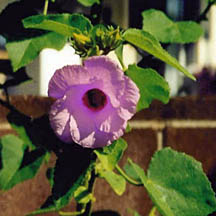
In the Garden![]()
Rick Barboza
’Akiohala
(Purple hibiscus)
LATIN NAME
Hibiscus furcellatus
Description: A medium-size hibiscus about 8 feet tall with rough leaves that are slightly to moderately lobed. New stems, flower buds and leaf surface are densely pubescent. They have awesome flowers that emerge on tall stems that stand up above the rest of the plant. Each flower is large and has light purple-pink petals with a dark purple center and staminal column. Once pollinated, the calyx will turn brown and be filled with many small, shiny brown seeds.
Distribution: This is the only native hibiscus, besides hau (Hibiscus tiliaceus), that is indigenous. It is native to Hawaii as well as Florida and South America; the rest of the native hibiscus are endemic. Here in Hawaii, 'akiohala is found on Kauai, Oahu, Maui and the Big Island in lowland wet areas, but was once much more widespread than its current population.
It is also available at the Home Depot for under $6.
Cultural uses: Flowers can be used medicinally as a laxative and also as a dye. Its bark can be stripped and woven into cordage.
Landscape uses and care: 'Akiohala is great as a specimen plant and requires little care. Although they are found naturally in wet areas, they need little watering in landscapes. Basically, they require full sun (to encourage profuse blooms) with daily watering only until established, when watering can be reduced.
Watch out for rose beetles that make holes in the leaves. Beetles can be eliminated by spraying with a systemic pesticide or by placing the plant near a light source at night, such as landscape lighting, a porch light or street light.
Also: Ever see purple bees before? Well, chances are if you own this plant, you will. Among the pollinators for this plant are the large black carpenter bees that people often call bumblebees. When these bees fly into the flower to retrieve nectar, their buzzing causes the purple pollen to sprinkle on them, covering their whole body so that they emerge purple.
'Akiohala also goes by the names 'akiahala, hauhele and hauhelewai, because it resembles our state flower, ma'ohauhele, but also because it is often found near fresh water, wai, hence the name hauhelewai.
Rick Barboza is co-owner of Hui Ku Maoli Ola, a native Hawaiian plant nursery. Contact him at 259-6580 or e-mail rickckbarboza@aol.com.
Gardening Calendar


